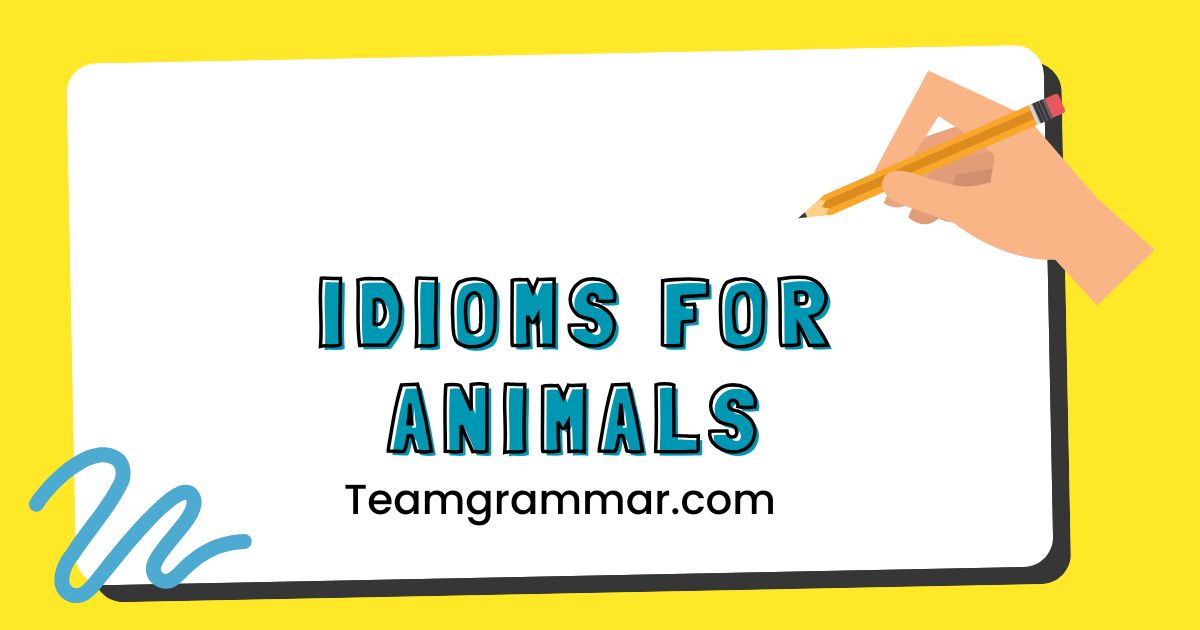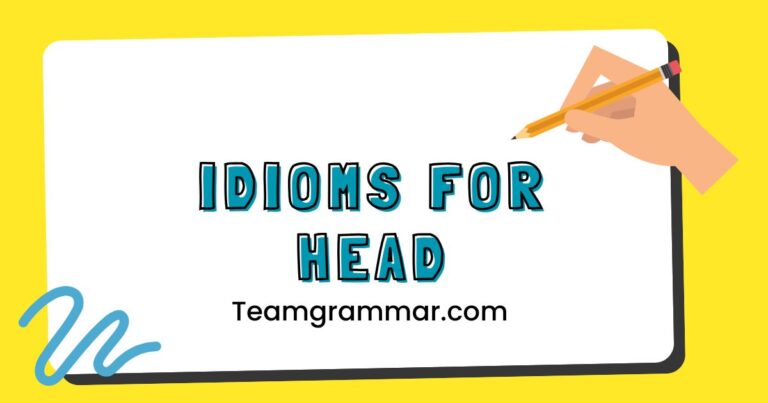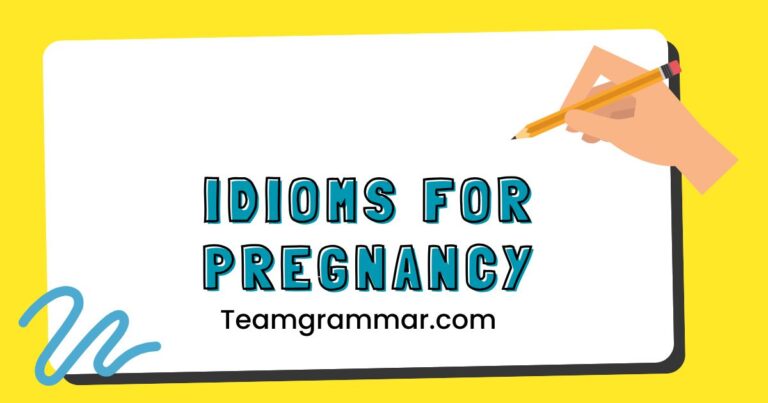31 Animal Idioms: Mastering Figurative Language in English
Idioms add color and depth to the English language, and those featuring animals are particularly vivid and memorable. Understanding these expressions is crucial for both comprehending native speakers and enriching your own communication.
This article provides a comprehensive guide to animal idioms, exploring their meanings, origins, and usage. Whether you’re an ESL student, a language enthusiast, or simply looking to improve your English fluency, this detailed resource will enhance your understanding and application of these fascinating figures of speech.
By the end of this guide, you’ll be able to confidently recognize and use animal idioms in various contexts, adding flair and nuance to your language skills.
Table of Contents
- Definition of Animal Idioms
- Structural Breakdown
- Types and Categories of Animal Idioms
- Examples of Animal Idioms
- Usage Rules for Animal Idioms
- Common Mistakes with Animal Idioms
- Practice Exercises
- Advanced Topics
- Frequently Asked Questions
- Conclusion
Definition of Animal Idioms
An idiom is a phrase or expression whose meaning cannot be understood from the literal meanings of the individual words. Instead, the phrase has a figurative meaning that is known through common use.
Animal idioms are a subset of idioms that specifically employ animals to convey a particular idea or emotion. These idioms often draw upon the perceived characteristics or behaviors of the animal in question to create a memorable and impactful image.
Animal idioms are classified asfigurative language, meaning they are not meant to be taken literally. Their function is to add color, emphasis, and cultural context to communication.
They are used extensively in both spoken and written English, appearing in everyday conversations, literature, and even formal presentations. Understanding animal idioms is essential for interpreting the nuances of English and avoiding miscommunication.
The context in which an animal idiom is used is crucial for understanding its meaning. For example, the phrase “to have butterflies in your stomach” doesn’t literally mean that insects are fluttering inside you.
Instead, it conveys a feeling of nervousness or anxiety, typically before an important event. The effectiveness of an animal idiom lies in its ability to evoke a strong image and convey complex emotions in a concise way.
Structural Breakdown
Animal idioms typically consist of a combination of nouns (the animal), verbs, and sometimes adjectives or adverbs. The structure can vary greatly depending on the specific idiom.
Some idioms are simple phrases, while others are more complex sentences. The key is that the meaning is not derived from the individual words but from the established usage of the entire phrase.
Many animal idioms follow a pattern of associating a specific animal with a particular trait. For example, “as sly as a fox” connects the fox with the characteristic of slyness or cunning.
This association is culturally ingrained and helps listeners quickly grasp the intended meaning. The structural patterns of animal idioms often rely on similes (using “like” or “as”) or metaphors (implied comparisons) to create vivid imagery.
Understanding the grammatical structure of an animal idiom can help in recognizing and remembering its meaning. While the literal interpretation is irrelevant, analyzing the components can provide clues about the intended connotation.
For instance, “to let the cat out of the bag” implies revealing a secret, with the image of a cat escaping from a bag suggesting the uncontrolled release of information. Here, the verb “let” and the prepositional phrase “out of the bag” play crucial roles in conveying the meaning.
Types and Categories of Animal Idioms
Based on Animal Type
Animal idioms can be categorized based on the type of animal featured. This classification helps in understanding the cultural associations and stereotypes linked to each animal.
Common categories include:
- Mammals: Such as dogs, cats, horses, and wolves.
- Birds: Such as eagles, owls, and chickens.
- Insects: Such as bees, ants, and butterflies.
- Reptiles and Amphibians: Such as snakes, turtles, and frogs.
- Fish: Such as sharks, whales, and goldfish.
Each category carries its own set of connotations. For example, idioms featuring birds often relate to freedom or perspective, while those involving snakes may suggest deceit or danger.
Consider the difference between “free as a bird” and “snake in the grass”.
Based on Meaning
Another way to categorize animal idioms is by their meaning or the emotions they convey. This approach is useful for learners who want to express specific feelings or ideas using idiomatic language.
Common categories include:
- Intelligence and Skill: Such as “as wise as an owl” or “sly as a fox”.
- Bravery and Strength: Such as “brave as a lion” or “strong as an ox”.
- Nervousness and Anxiety: Such as “butterflies in your stomach”.
- Laziness and Apathy: Such as “playing possum”.
- Aggression and Anger: Such as “mad as a hornet”.
By understanding these categories, learners can more easily select the appropriate idiom to express their intended meaning. For instance, if you want to describe someone who is very intelligent, you might choose “as wise as an owl” rather than “eager beaver”.
Based on Usage
Animal idioms can also be categorized based on how they are used in sentences. Some idioms are used as adjectives, while others function as verbs or adverbs.
This classification helps in understanding the grammatical role of the idiom within a sentence.
- Adjectival Idioms: These idioms describe a noun, such as “as busy as a bee”.
- Verbal Idioms: These idioms act as verbs, such as “to chicken out” (to avoid something due to fear).
- Adverbial Idioms: These idioms modify a verb, adjective, or another adverb, such as “work like a dog” (to work very hard).
Recognizing the grammatical function of an animal idiom is essential for using it correctly in a sentence. Understanding whether an idiom is adjectival, verbal, or adverbial will help you place it properly within the sentence structure.
Examples of Animal Idioms
The following tables provide extensive examples of animal idioms, categorized by the animal they feature. Each entry includes the idiom, its meaning, and an example sentence to illustrate its usage.
Dog Idioms
Dog idioms are common in English and often relate to loyalty, obedience, or difficulty.
| Idiom | Meaning | Example Sentence |
|---|---|---|
| A dog’s life | A miserable existence | He’s been having a dog’s life since he lost his job. |
| Barking up the wrong tree | Accusing the wrong person or pursuing the wrong course | If you think I stole your pen, you’re barking up the wrong tree. |
| Let sleeping dogs lie | Avoid stirring up trouble | I wouldn’t bring up that argument again; it’s best to let sleeping dogs lie. |
| Every dog has its day | Everyone will have their moment of success | Don’t worry, every dog has its day, and yours will come. |
| Go to the dogs | Deteriorate or decline | Since the new management took over, the company has gone to the dogs. |
| Work like a dog | Work very hard | She has to work like a dog to support her family. |
| Dog-eat-dog | Ruthlessly competitive | The business world can be dog-eat-dog, so you need to be tough. |
| In the doghouse | In trouble or disfavor | He’s in the doghouse with his wife for forgetting their anniversary. |
| As sick as a dog | Very ill | I was as sick as a dog last week with the flu. |
| Like a dog with a bone | Tenaciously holding onto something | She’s like a dog with a bone when she’s researching a new topic. |
| You can’t teach an old dog new tricks | It’s difficult to change someone’s habits | He’s been doing it this way for years; you can’t teach an old dog new tricks. |
| A lucky dog | A fortunate person | He won the lottery; he’s a lucky dog! |
| Three dog night | A very cold night | It was a three dog night last winter, we had to pile on the blankets. |
| The hair of the dog | An alcoholic drink taken to cure a hangover | I’m going to need the hair of the dog after last night’s party. |
| To lead a dog’s life | To have a miserable, unhappy existence | He felt like he was leading a dog’s life, with no joy or excitement. |
| Fight like cats and dogs | To argue frequently and intensely | The siblings fight like cats and dogs whenever they’re together. |
| Call off the dogs | To stop pursuing or attacking someone | The media finally called off the dogs after the scandal died down. |
| Tail wagging the dog | When a small or unimportant part controls the whole | In that company, the intern is wagging the dog, making all the important decisions. |
| Die like a dog | To die a miserable and lonely death | No one should have to die like a dog, without comfort or care. |
| Put on the dog | To behave pretentiously or show off | They really put on the dog for the visiting dignitaries, showing off all their wealth. |
| Dog and pony show | An elaborate presentation often used to impress | The sales team put on a dog and pony show to try and win the contract. |
Cat Idioms
Cat idioms often relate to stealth, independence, or danger.
| Idiom | Meaning | Example Sentence |
|---|---|---|
| Let the cat out of the bag | Reveal a secret | I accidentally let the cat out of the bag about the surprise party. |
| Curiosity killed the cat | Being too inquisitive can lead to trouble | I know you’re curious, but remember, curiosity killed the cat. |
| Cat got your tongue? | Why aren’t you speaking? | You’re awfully quiet tonight; cat got your tongue? |
| Like herding cats | Difficult to control or organize | Trying to get everyone to agree on a time is like herding cats. |
| There’s more than one way to skin a cat | There are multiple ways to achieve a goal | Don’t give up; there’s more than one way to skin a cat. |
| A cat nap | A short, light sleep | I’m going to take a cat nap before we go out. |
| Look what the cat dragged in | Said when someone arrives looking untidy | Well, look what the cat dragged in! You look terrible. |
| Copycat | Someone who imitates others | He’s such a copycat; he always copies my ideas. |
| Play cat and mouse | To tease or torment someone | The police played cat and mouse with the suspect for weeks. |
| When the cat’s away, the mice will play | People misbehave when the authority figure is absent | The kids had a party when their parents were away; when the cat’s away, the mice will play. |
| Grinning like a Cheshire cat | To have a wide, mischievous grin | He was grinning like a Cheshire cat after pulling the prank. |
| Enough room to swing a cat | A small, cramped space | This apartment is so small, there isn’t enough room to swing a cat. |
| Put the cat among the pigeons | To cause a disturbance or controversy | His controversial remarks really put the cat among the pigeons at the meeting. |
| Raining cats and dogs | Raining very heavily | It’s raining cats and dogs outside, so bring an umbrella. |
| See which way the cat jumps | To wait and see how things develop before making a decision | I’m going to see which way the cat jumps before I invest in the company. |
| Like the cat that got the cream | Looking very pleased with oneself | She looked like the cat that got the cream after winning the award. |
| Fight like cats and dogs | To argue frequently and intensely | The siblings fight like cats and dogs whenever they’re together. |
| Bell the cat | To perform a risky or dangerous task | No one wanted to bell the cat and tell the boss he was wrong. |
| A scaredy cat | A person who is easily frightened | Don’t be such a scaredy cat; it’s just a spider. |
| Fat cat | A wealthy and privileged person, often in business or politics | The fat cats on Wall Street are getting richer while everyone else struggles. |
Bird Idioms
Bird idioms often relate to freedom, perspective, or early risers.
| Idiom | Meaning | Example Sentence |
|---|---|---|
| Free as a bird | Completely free and unrestricted | Now that I’m retired, I feel as free as a bird. |
| A bird in the hand is worth two in the bush | It’s better to hold onto something you have than risk losing it to get something bigger | I was tempted to quit my job for a better one, but a bird in the hand is worth two in the bush. |
| Early bird catches the worm | Arriving early gives you an advantage | I got the best deal because the early bird catches the worm. |
| Kill two birds with one stone | Achieve two things with one action | By walking to work, I kill two birds with one stone: exercise and save money. |
| Birds of a feather flock together | People with similar interests hang out together | They’re always together; birds of a feather flock together. |
| For the birds | Worthless or uninteresting | That movie was for the birds; I didn’t enjoy it at all. |
| Eat like a bird | Eat very little | She eats like a bird, so she’s always hungry. |
| A little bird told me | I heard a secret from someone | A little bird told me that you’re getting married. |
| As the crow flies | In a straight line | It’s only five miles as the crow flies, but much longer by road. |
| Mad as a hen | Very upset or angry | She was as mad as a hen when she found out what he did. |
| Rare bird | An unusual or exceptional person | He’s a rare bird, always willing to help others. |
| Ugly duckling | Someone who starts out unattractive but becomes beautiful or successful | She was the ugly duckling in high school, but now she’s a successful model. |
| Sitting duck | An easy target | Without protection, they were sitting ducks for the enemy. |
| Spread your wings | To become independent and explore new opportunities | It’s time for you to spread your wings and see the world. |
| Eagle eye | Having sharp vision or attention to detail | The accountant has an eagle eye for spotting errors. |
| Fly the coop | To escape or leave a place suddenly | He decided to fly the coop and move to a tropical island. |
| Nest egg | Savings for the future | She has a nice nest egg saved up for retirement. |
| Pecking order | Hierarchy or ranking in a group | There’s a clear pecking order in this office. |
| Rule the roost | To be in charge or control | She rules the roost in her family. |
| As light as a feather | Very light in weight | The pillow was as light as a feather. |
Other Animal Idioms
This table includes a variety of animal idioms that don’t fit neatly into the above categories.
| Idiom | Meaning | Example Sentence |
|---|---|---|
| Busy as a bee | Very busy | She’s been as busy as a bee preparing for the conference. |
| Have butterflies in your stomach | Feel nervous | I always have butterflies in my stomach before a presentation. |
| Strong as an ox | Very strong | He’s as strong as an ox; he can lift anything. |
| Sly as a fox | Cunning and deceitful | He’s as sly as a fox; don’t trust him. |
| Brave as a lion | Very brave | She was brave as a lion when she stood up to the bully. |
| Wise as an owl | Very wise | My grandfather is as wise as an owl; he always gives good advice. |
| Eager beaver | Someone who is very enthusiastic and hardworking | He’s such an eager beaver; he’s always the first to volunteer. |
| Like a fish out of water | Feeling uncomfortable in a new situation | I felt like a fish out of water at the formal party. |
| Happy as a clam | Very happy | She’s as happy as a clam now that she’s retired. |
| Smell a rat | Suspect something is wrong | I smell a rat; something doesn’t seem right about this deal. |
| Wolf in sheep’s clothing | Someone who appears harmless but is actually dangerous | He seemed nice at first, but he turned out to be a wolf in sheep’s clothing. |
| Hold your horses | Wait a moment | Hold your horses! I’m not ready yet. |
| Straight from the horse’s mouth | From a reliable source | I heard it straight from the horse’s mouth that he’s getting promoted. |
| Get off your high horse | Stop acting superior | You need to get off your high horse and listen to what others have to say. |
| Guinea pig | A subject for experimentation | We were used as guinea pigs for the new drug. |
| Like a bull in a china shop | Clumsy and careless | He’s like a bull in a china shop; he always breaks things. |
| Have a whale of a time | Have a great time | We had a whale of a time at the party. |
| As gentle as a lamb | Very gentle and kind | She’s as gentle as a lamb with the children. |
| Play possum | Pretend to be dead or asleep | He played possum when his mother asked him to do chores. |
| Swan song | Final performance or act | This concert will be her swan song before she retires. |
| Cash cow | A business or product that generates a lot of money | That product is their cash cow; it brings in most of their revenue. |
| The world is your oyster | You have many opportunities available to you | Now that you’ve graduated, the world is your oyster. |
Usage Rules for Animal Idioms
Using animal idioms correctly requires attention to context and nuance. While idioms are generally fixed expressions, some flexibility exists in their usage.
Here are some rules to consider:
- Maintain the Structure: Avoid altering the core structure of the idiom. While minor variations may be acceptable, significant changes can render the idiom incomprehensible. For example, instead of saying “as sly a fox”, use the correct form “as sly as a fox”.
- Consider the Audience: Be mindful of your audience’s familiarity with the idiom. If you’re speaking to non-native English speakers or individuals unfamiliar with the expression, it’s best to avoid it or provide a clear explanation.
- Pay Attention to Tone: Idioms can convey different tones, from humorous to serious. Choose idioms that are appropriate for the context and your intended message. For example, using “raining cats and dogs” in a formal presentation might be inappropriate.
- Avoid Overuse: While idioms can add color to your language, overuse can make your speech sound unnatural or forced. Use them sparingly and only when they enhance your message.
- Understand Cultural Context: Some animal idioms may have different connotations in different cultures. Be aware of these variations to avoid miscommunication. For instance, an idiom that is considered humorous in one culture might be offensive in another.
Here is a table summarizing these usage rules:
| Rule | Description | Example |
|---|---|---|
| Maintain Structure | Keep the idiom’s structure intact. | Correct: “As busy as a bee.” Incorrect: “As busy a bee.” |
| Consider Audience | Ensure your audience understands the idiom. | Explain the idiom to non-native speakers. |
| Pay Attention to Tone | Use idioms appropriate for the context. | Avoid humorous idioms in formal settings. |
| Avoid Overuse | Use idioms sparingly. | Don’t pepper your speech with too many idioms. |
| Understand Cultural Context | Be aware of cultural differences in idiom meaning. | Research the idiom’s connotation in different cultures. |
Common Mistakes with Animal Idioms
Learners often make mistakes when using animal idioms. Here are some common errors and how to avoid them:
- Literal Interpretation: The most common mistake is interpreting the idiom literally. Remember that idioms have figurative meanings.
- Incorrect Word Choice: Using the wrong word in an idiom can change its meaning or make it nonsensical.
- Misunderstanding Connotations: Not understanding the emotional or cultural associations of an idiom can lead to inappropriate usage.
- Overusing Idioms: Using too many idioms can make your speech sound unnatural and forced.
The following table illustrates some common mistakes and provides correct examples:
| Incorrect | Correct | Explanation |
|---|---|---|
| I have real butterflies in my stomach. | I have butterflies in my stomach. | Avoid literal interpretation; it’s a feeling of nervousness. |
| Let the dog out of the bag. | Let the cat out of the bag. | Use the correct animal and wording. |
| He’s as wise as a horse. | He’s as wise as an owl. | Owls are traditionally associated with wisdom. |
| She’s working like a horse every day, she loves it. | She’s working like a dog every day, but she doesn’t complain. | “Working like a dog” implies hard, often unpleasant, work. |
Practice Exercises
Exercise 1: Fill in the Blanks
Complete the following sentences with the correct animal idiom.
| Question | Answer |
|---|---|
| 1. He’s as __________ as an owl. | wise |
| 2. I have __________ in my stomach before the exam. | butterflies |
| 3. She works like a __________. | dog |
| 4. Don’t __________ the cat out of the bag! | let |
| 5. They fight like __________ and __________. | cats, dogs |
| 6. The __________ bird catches the worm. | early |
| 7. She’s as free as a __________. | bird |
| 8. He’s as sly as a __________. | fox |
| 9. I __________ a rat; something’s not right. | smell |
| 10. He’s __________ in sheep’s clothing. | wolf |
Exercise 2: Matching
Match the idiom with its meaning.
| Idiom | Meaning |
|---|---|
| 1. Hold your horses | A. Extremely happy |
| 2. Happy as a clam | B. Suspect something is wrong |
| 3. Smell a rat | C. Wait a moment |
| 4. Like a fish out of water | D. Brave |
| 5. Brave as a lion | E. Feeling uncomfortable |
Answers:
1-C, 2-A, 3-B, 4-E, 5-D
Exercise 3: Sentence Completion
Choose the best idiom to complete each sentence.
| Question | Options | Answer |
|---|---|---|
| 1. He’s always first to volunteer; he’s an __________. | A. eager beaver, B. wise owl, C. sly fox | A. eager beaver |
| 2. We had a __________ at the party. | A. dog’s life, B. whale of a time, C. cat nap | B. whale of a time |
| 3. She felt __________ at the formal event. | A. like a fish out of water, B. free as a bird, C. happy as a clam | A. like a fish out of water |
| 4. He told me __________ that he’s getting promoted. | A. straight from the horse’s mouth, B. a little bird told me, C. let the cat out of the bag | A. straight from the horse’s mouth |
| 5. It’s raining __________, so take an umbrella. | A. cats and dogs, B. birds of a feather, C. butterflies | A. cats and dogs |
Advanced Topics
For advanced learners, exploring the origins and evolution of animal idioms can provide deeper insights into the English language. Many idioms have historical roots that reflect cultural beliefs and practices.
Researching the etymology of these expressions can reveal fascinating stories about their development over time.
Another advanced topic is the use of animal idioms in literature and rhetoric. Authors often employ idioms to create vivid imagery, develop characters, and convey complex themes.
Analyzing how idioms are used in literary works can enhance your understanding of their impact and effectiveness.
Furthermore, comparing animal idioms across different languages can reveal interesting cultural differences. While some idioms may have direct equivalents in other languages, others may be unique to a particular culture.
Exploring these variations can broaden your linguistic awareness and appreciation.
Frequently Asked Questions
- What is an animal idiom?
An animal idiom is a phrase or expression that uses animals to convey a figurative meaning, different from the literal definition of the words used. These idioms often rely on cultural associations and stereotypes linked to specific animals to create vivid and memorable images.
- Why are animal idioms important to learn?
Learning animal idioms is crucial for understanding native English speakers and enriching your own communication. These idioms are commonly used in everyday conversations, literature, and various forms of media. Knowing them allows you to grasp the nuances of the language and avoid misinterpretations.
- How can I improve my understanding of animal idioms?
To improve your understanding, start by studying common animal idioms and their meanings. Pay attention to the context in which they are used and practice using them in your own speech and writing. Reading English literature and watching English-language movies and TV shows can also help you become more familiar with these expressions.
- Are animal idioms the same in all English-speaking countries?
While many animal idioms are universal across English-speaking countries, some regional variations exist. It’s essential to be aware of these differences to avoid confusion or miscommunication. For instance, an idiom common in the United States might not be as well-known in the United Kingdom, and vice versa.
- Can I create my own animal idioms?
While it’s generally not recommended to create your own idioms, as they might not be understood by others, you can certainly play with language creatively. However, for effective communication, it’s best to stick to established idioms that are widely recognized and understood.
- How do I avoid misusing animal idioms?
To avoid misusing animal idioms, ensure you understand their precise meaning and usage. Pay attention to the context in which they are used and avoid altering their structure. If you’re unsure about an idiom’s meaning, look it up in a dictionary or ask a native English speaker for clarification.
- What is the difference between an idiom and a proverb?
An idiom is a phrase whose meaning is different from the literal meanings of its individual words, while a proverb is a short, well-known saying that expresses a general truth or piece of advice. Idioms are more about figurative language, while proverbs are about conveying wisdom or moral lessons.
- Are there any animal idioms that should be avoided?
Some animal idioms may be considered offensive or insensitive, depending on the context and audience. It’s important to be mindful of the potential impact of your words and avoid using idioms that could be perceived as discriminatory or disrespectful. Always consider your audience and the tone of your communication.
- Where can I find more examples of animal idioms?
You can find more examples of animal idioms in dictionaries, idiom dictionaries, online resources, and English literature. Many websites and apps are dedicated to teaching idioms, providing definitions, examples, and quizzes to help you learn and practice.
- How do I teach animal idioms to ESL students?
When teaching animal idioms to ESL students, start with simple and common idioms. Use visual aids, real-life examples, and interactive activities to
add
Conclusion
Animal idioms are a vibrant and essential part of the English language. By understanding their definitions, structural components, types, and usage rules, you can enhance your communication skills and gain a deeper appreciation for the nuances of English.
This comprehensive guide has provided you with the knowledge and tools necessary to master animal idioms, avoid common mistakes, and use these expressions effectively in various contexts. Keep practicing and exploring, and you’ll soon find yourself speaking with greater fluency and confidence.







